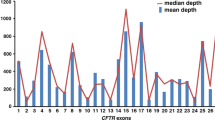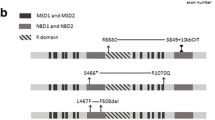Abstract
The creation of precise clinical mutations by gene targeting is important in elucidating disease pathogenesis using mouse models. 'Hit and run' gene targeting is an elegant method to achieve this goal. This uses first a positive selection to introduce the targeting vector carrying the required mutation and then a negative selection to identify clones which have removed vector and wild-type sequences by intrachromosomal recombination. However, this approach has only been successfully used in a handful of cases. We used this procedure to introduce precise clinical mutations into the exon 10 region of the cystic fibrosis transmembrane conductance regulator (Cftr) gene. Using a CMV promoter driven hygromycin/thymidine kinase (hyg/tk) fusion gene as both our dominant and negative selectable marker, we targeted the Cftr locus very efficiently but only identified false runs after the negative selection step. This defect in thymidine kinase induced toxicity to gancyclovir correlated with methylation of the transgene. Consequently we devised a stringent screening procedure to select only true 'run' clones. Unfortunately these 'run' clones had lost the mutation so we altered the vector design to bias the run step to retain the mutation and used a different tk selection cassette with a HSVtk promoter sequence. This new vector design allowed both efficient 'hit and run' for two cystic fibrosis (CF) mutations with no false positives and successful germline transmission of the novel G480C missense mutation.
Similar content being viewed by others
References
Askew GR, Doetschman T and Lingrel JB (1993) Site-directed point mutations in embryonic stem cells: a gene-targeting, tagand-exchange strategy. Mol Cell Biol 13: 4115–4124.
Colledge WH, Abella BS, Southern KW, Ratcliff R, Jiang C, Cheng SH, MacVinish LJ, Anderson JR, Cuthbert AW and Evans MJ (1995) Generation and characterization of a delta F508 cystic fibrosis mouse model. Nat Genet 10: 445–450.
Delaney SJ, Alton EWFW, Smith SN, Lunn DP, Farley R, Lovelock PK, Thomson SA, Hume DA, Lamb D, Porteous DJ, Dorin JR and Wainwright BJ (1996) Cystic-fibrosis mice carrying the missense mutation G551D replicate human genotype-phenotype correlations. EMBO J 15: 955–963.
Deng C, Thomas KR and Capecchi MR (1993) Location of crossovers during gene targeting with insertion and replacement vectors. Mol Cell Biol 13: 2134–2139.
Dickinson P, Kimber L, Kilanowski FM, Stevenson BJ, Porteous DJ and Dorin JR (1993) High frequency gene targeting using insertional vectors. Human Mol Genet 2: 1299–1302.
Dorin JR, Dickinson P, Alton EWFW, Smith SN, Geddes DM, S tevenson BJ, Kimber WL, Fleming S, Clarke AR, Hooper ML, Anderson L, Beddington RSP and Porteous DJ (1992) Cystic fibrosis in the mouse by targeted insertional mutagenesis. Nature 359: 211–215.
Fiering S, Epner E, Robinson K, Zhuang Y, Telling A, Hu M, Martin DI, Enver T, Ley TJ and Groudine M (1995) Targeted deletion of 5′HS2 of the murine beta-globin LCR reveals that it is not essential for proper regulation of the beta-globin locus. Genes Dev 9: 2203–2213.
Gschwind M and Huber G (1998) Introduction of hereditary disease-associated mutations into the beta-amyloid precursor protein gene of mouse embryonic stem cells: a comparison of homologous recombination methods. Mol Cell Biol 18: 4651–4658.
Hasty P, Ramirez-Solis R, Krumlauf R and Bradley A (1991) Introduction of a subtle mutation into the Hox-2.6 locus in embryonic stem cells. Nature 350: 243–246.
Kass SU, Goddard JP and Adams RLP (1993) Inactive chromatin spreads from a focus of methylation. Mol Cell Biol 13: 7372–7379.
Lupton SD, Brunton LL, Kalberg VA and Overell RW (1991) Dominant positive and negative selection using a hygromycin phosphotransferase-thymidine kinase fusion gene. Mol Cell Biol 11: 3374–3378.
Melton DW, Ketchen AM and Selfridge J (1997) Stability of HPRT marker gene expression at different gene-targeted loci: observing and overcoming a position effect. Nucleic Acids Res 25: 3937–3943.
Meyers EN, Lewandoski M and Martin GR (1998) An Fgf8 mutant allelic series generated by Cre-and Flp-mediated recombination. Nat Genet 18: 136–141.
Moore RC, Redhead NJ, Selfridge J, Hope J, Manson JC and Melton DW (1995) Double replacement gene targeting for the production of a series of mouse strains with different prion protein gene alterations. Bio/Technology 13: 999–1004.
Ramirez-Solis R, Zeng H, Whiting J, Krumlauf R and Bradley A (1993) Hox-4b (Hox-2.6) mutant mice show homeotic transformation of a cervical vertebra and defects in the closure of the sternal rudiments. Cell 73: 279–294.
Stacey A, Schnieke A, McWhir J, Cooper J, Colman A and Melton DW (1994) Use of double-replacement gene targeting to replace the murine alpha-lactalbumin gene with its human counterpart in embryonic stem cells and mice. Mol Cell Biol 14: 1009–1016.
Thomas KR and Capecchi MR (1987) Site-directed mutagenesis by gene targeting in mouse embryo-derived stem cells. Cell 51: 503–512.
Valancius V and Smithies O (1991a) Double-strand gap repair in a mammalian gene targeting reaction. Mol Cell Biol 11: 4389–4397.
Valancius V and Smithies O (1991b) Testing an' In-Out' targeting procedure for making subtle genomic modifications in mouse embryonic stem cells. Mol Cell Biol 11: 1402–1408.
van Doorninck JH, French PJ, Verbeek E, Peters RH, Morreau H, Bijman J and Scholte BJ (1995) A mouse model for the cystic fibrosis delta F508 mutation. EMBO J 14: 4403–4411.
Wu H, Liu X and Jaenisch R (1994) Double replacement: strategy for efficient introduction of subtle mutations into the murine Col1a-1 gene by homologous recombination in embryonic stem cells. Proc Natl Acad Sci USA 91: 2819–2823.
Author information
Authors and Affiliations
Rights and permissions
About this article
Cite this article
Dickinson, P., Kimber, W.L., Kilanowski, F.M. et al. Enhancing the efficiency of introducing precise mutations into the mouse genome by hit and run gene targeting. Transgenic Res 9, 55–66 (2000). https://doi.org/10.1023/A:1008915026660
Issue Date:
DOI: https://doi.org/10.1023/A:1008915026660




